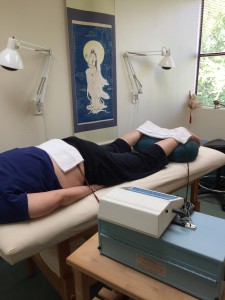About Frequency Specific Microcurrent
 I have over ten years of advanced training in the use of Frequency Specific Microcurrent. I first used microcurrent in my acupuncture practice in 1989. Since this time the technology and techniques of using FSM have evolved considerably.
I have over ten years of advanced training in the use of Frequency Specific Microcurrent. I first used microcurrent in my acupuncture practice in 1989. Since this time the technology and techniques of using FSM have evolved considerably.
I treat a wide variety of musculoskeletal conditions using state-of-the-art, FDA-approved FSM equipment. Using this modality has produced extraordinary results in healing injuries, resolving chronic pain issues, and general pain reduction.
Frequency Specific Microcurrent
* Accelerates healing
* Reduces Inflammation quickly
* Is painless
* Uses FDA-approved machines
* Treats many conditions, both acute and chronic
History of Microcurrent Treatment
Microcurrent was introduced in the United States as a physical therapy modality in the late 1970s by Dr. Thomas Wing, a chiropractor and acupuncturist. Because of its ability to increase ATP (the fuel that powers each cell) as much as 500% (5 X) (Cheng et al 1982), microcurrent was used successfully to control pain, increase the rate of healing of sports injuries, and heal bone fractures and wounds up to 30% faster (Stanish 1988).
The name Frequency Specific Microcurrent (FSM) comes from the discovery that specific conditions and specific tissues respond to distinct frequencies. Today’s microcurrent machines are approved by the FDA for use as TENS (transcutaneous electrical nerve stimulation) devices, programmed to deliver treatment protocols matched to each patient’s unique diagnosis.
FSM effectively treats these conditions (partial list):
* New injury
* Chronic pain from injuries and repetitive stress
* Muscle pain and injury
* Concussion
* Nerve pain and neuropathy
* Post-surgical healing
* Shingles pain and post-herpetic neuralgia
* Acute fractures
* Sprains and strains
* Disc (pinched nerve) pain
* Plantar fasciitis
* Recovery from the effects of anesthesia
* Radiation-induced scarring and pain
How FSM Is Different
Other widely used electrotherapies use currents one thousand times stronger than FSM, which can cause a buzzing or pulsing sensation. Unlike microcurrent, they do not affect the physiology of the cell, contain few frequencies, and are not programmable. FSM delivers unique, sub-sensory current at the same level of current the body itself produces in every cell and tissue. It is highly programmable and completely painless.
Research Findings
Research done by Bourguigonon in 1987- 89 found that microcurrent: enhances tissue repair, protein and DNA synthesis; improves insulin binding, and increases intracellular calcium uptake. FSM has the ability to stimulate cellular physiology and growth, making it extremely effective for healing tissue and relieving chronic pain.
For a list of published papers, go to www.frequencyspecific.com.